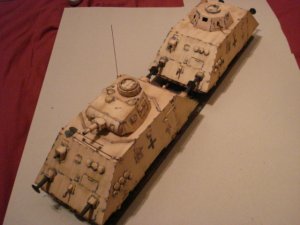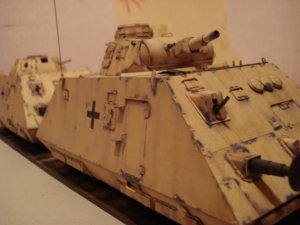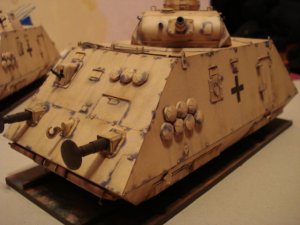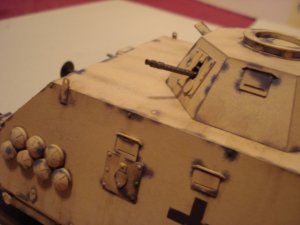history
from the first use of armored trains there has always been a number of weaknesses that have been exploited the main one is that the train is tied to its tracks ,the other is that all locomotive power was provided by one or more engines disableing the trains power leaves it vunerable the best way to create cars that propell themselves.
the concept of self propelled rail armor in the form of single vehicles has been tried and used sucessfully in a huge number of different forms reaching its ultimate conclusion in the rail crusiers large self propelled vehicles which could be used individuly or as part of a train ,these however could not however replace the armoured trains in the number of applications a full train could another idea developed in pre war poland was the idea of a modular train consiting of a number of vehicles each fulfilling a particular task yet maintaing its own locomotive power this concept could never be acted apon before the german invasion.
the germans began the war with no rail armour to speak of they had been phased out in favor of more modern battle systems,the sucsessful use of trains/rail armour by the polish and later soveits and the need for security for the vast areas of german occupation promted there re-emergence.
the first trains were very basic consiting of armored flatbed cars and older captured armored cars before more advanced trains arived(bp 42) these however were still powered by a single locomotive.
it wasnt until late 1943 that the polish concept of a modular train was revived two types were planned a light scout car train and a heavy scout car train also referred to as SchienenPanzer
heavy scout car train/SchienenPanzer
these vehicles were produced produced by Steyer in 1944 and 1945 They weighed approximately 18 ton, with 20mm armor plate. They were powered by a air cooled 76-HP Steyer motor which was used on the light train this left them a little underpowered several variants were produced to serve different purposes to create a full train yet also maintain independent if needs be the train consisted of the following
Panhard 178-P204 X1-2
a captured french panhard scout car converted for rail use with buffers and flanged wheels
pusher car X2-3
basic flatbed car to protect the main train and carry supplies
tank carrier car X2
special flatbed car with raised sides to protect the tanks running gear the tank would have been a Praga 38(t) or a french Somua S-35
AA FlakWagen X2
proposed
base steyer vehicle armed with 2x light mgs + 2x heavy mgs in interchangable positions mounting a 4 barrel flak turret never produced due to matirial shortages
Artillerywagen X4
base steyer vehicle armed with 2x light mgs + 2x heavy mgs in interchangable positions mounting a pzkpfz 3 or early pzkpfz 4 turret mounting a short 7.5 cm gun
infantriewagen X4
base steyer vehicle armed with 2x light mgs + 3x heavy mgs in interchangable positions intended to carry infantry and to sleep the trains crew
2 KommandoWagen X2
base steyer vehicle armed with 2x light mgs + 3x heavy mgs in interchangable positions the same layout as the infantriewagen with the addition of a frame antenna intended to control train operations,communications ,logistical support and first aid
these trains were completed in 1944 and went into service without there aa cars These heavy armored rail cars were used in service in Russia and Yugoslavia, and the balkans because of the lack of aa cars and other factors these vehicles rarely operated as a train instead were broken up into small groups or pairs after the war Czechoslovakia used a number until the mid 50s
the kit
as far as i know gpm is the only company that publishes rail armour and this kit is one of the more recent and it shows the printing is exelent on good cardstock it also contains two kits unlike other gpm kits ive built that just give parts to produce a desired variant the construction of the kit is very simple the only parts of difficulty are the vehicles "skins" which reqire trimming and lots of dry fitting to obtain a good result the completed kit is good looking with a very nice weathering this is also the first kit were i have made extensive use of rivets the kommadowagen still reqires its frame antenna to complete it but otherwise this is a completed kit:mrgreen:
from the first use of armored trains there has always been a number of weaknesses that have been exploited the main one is that the train is tied to its tracks ,the other is that all locomotive power was provided by one or more engines disableing the trains power leaves it vunerable the best way to create cars that propell themselves.
the concept of self propelled rail armor in the form of single vehicles has been tried and used sucessfully in a huge number of different forms reaching its ultimate conclusion in the rail crusiers large self propelled vehicles which could be used individuly or as part of a train ,these however could not however replace the armoured trains in the number of applications a full train could another idea developed in pre war poland was the idea of a modular train consiting of a number of vehicles each fulfilling a particular task yet maintaing its own locomotive power this concept could never be acted apon before the german invasion.
the germans began the war with no rail armour to speak of they had been phased out in favor of more modern battle systems,the sucsessful use of trains/rail armour by the polish and later soveits and the need for security for the vast areas of german occupation promted there re-emergence.
the first trains were very basic consiting of armored flatbed cars and older captured armored cars before more advanced trains arived(bp 42) these however were still powered by a single locomotive.
it wasnt until late 1943 that the polish concept of a modular train was revived two types were planned a light scout car train and a heavy scout car train also referred to as SchienenPanzer
heavy scout car train/SchienenPanzer
these vehicles were produced produced by Steyer in 1944 and 1945 They weighed approximately 18 ton, with 20mm armor plate. They were powered by a air cooled 76-HP Steyer motor which was used on the light train this left them a little underpowered several variants were produced to serve different purposes to create a full train yet also maintain independent if needs be the train consisted of the following
Panhard 178-P204 X1-2
a captured french panhard scout car converted for rail use with buffers and flanged wheels
pusher car X2-3
basic flatbed car to protect the main train and carry supplies
tank carrier car X2
special flatbed car with raised sides to protect the tanks running gear the tank would have been a Praga 38(t) or a french Somua S-35
AA FlakWagen X2
proposed
base steyer vehicle armed with 2x light mgs + 2x heavy mgs in interchangable positions mounting a 4 barrel flak turret never produced due to matirial shortages
Artillerywagen X4
base steyer vehicle armed with 2x light mgs + 2x heavy mgs in interchangable positions mounting a pzkpfz 3 or early pzkpfz 4 turret mounting a short 7.5 cm gun
infantriewagen X4
base steyer vehicle armed with 2x light mgs + 3x heavy mgs in interchangable positions intended to carry infantry and to sleep the trains crew
2 KommandoWagen X2
base steyer vehicle armed with 2x light mgs + 3x heavy mgs in interchangable positions the same layout as the infantriewagen with the addition of a frame antenna intended to control train operations,communications ,logistical support and first aid
these trains were completed in 1944 and went into service without there aa cars These heavy armored rail cars were used in service in Russia and Yugoslavia, and the balkans because of the lack of aa cars and other factors these vehicles rarely operated as a train instead were broken up into small groups or pairs after the war Czechoslovakia used a number until the mid 50s
the kit
as far as i know gpm is the only company that publishes rail armour and this kit is one of the more recent and it shows the printing is exelent on good cardstock it also contains two kits unlike other gpm kits ive built that just give parts to produce a desired variant the construction of the kit is very simple the only parts of difficulty are the vehicles "skins" which reqire trimming and lots of dry fitting to obtain a good result the completed kit is good looking with a very nice weathering this is also the first kit were i have made extensive use of rivets the kommadowagen still reqires its frame antenna to complete it but otherwise this is a completed kit:mrgreen:





